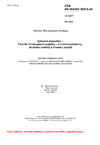Vánoční provoz a PF 2026
Vážení zákazníci,
aby bylo možné dodat objednané zboží před začátkem vánočních svátků, odešleme poslední várku zboží v tomto roce v pátek 19. prosince. Objednávky došlé po 10. hodině 19. prosince odešleme až 5. ledna 2026. Od 19. prosince do 2. ledna taktéž nebude možný osobní odběr objednaných norem.
Děkujeme za váš zájem v tomto roce,
přejeme vám hodně zdraví, pohody a úspěchů v roce 2026.
ČSN EN ISO/IEC 80079-49 (389671)
Výbušné atmosféry - Část 49: Protiexplozní pojistky - Funkční požadavky, zkušební metody a omezení použití
Anotace obsahu normy
This document specifies the requirements for flame arresters that prevent flame transmission when explosive gas-air or vapour-air mixtures are present. It establishes uniform principles for the classification, basic construction and information for use, including the marking of flame arresters, and specifies test methods to verify the safety requirements and determine safe limits of use.
This document is applicable to pressures ranging from 80 kPa to 160 kPa and temperatures ranging from -20 °C to +200 °C.
NOTE 1 - For flame arresters with operational conditions inside the scope, but outside atmospheric conditions, see Annex E.
NOTE 2 - In designing and testing flame arresters for operation under conditions other than those specified above, this document can be used as a guide. This document can also be used to design any additional testing related to the specific conditions of use. This is particularly important when high temperatures and pressures are applied. The test mixtures might need to be modified in these cases.
This document does not apply to the following:
- external safety-related measurement and control equipment that might be required to keep the operational conditions within the established safe limits;
NOTE 3 - Integrated measurement and control equipment, such as integrated temperature and flame sensors as well as parts which, for example, intentionally melt (retaining pin), burn away (weather hoods) or bend (bimetallic strips), are within the scope of this document.
- flame arresters used for explosive mixtures of vapours and gases, which tend to self-decompose (for example, acetylene) or which are chemically unstable;
- flame arresters used for carbon disulfide, due to its special properties;
- flame arresters whose intended use is for mixtures other than gas-air or vapour-air mixtures (for example, higher oxygen-nitrogen ratio, chlorine as oxidant);
- flame arrester test procedures for reciprocating internal combustion engines;
NOTE 4 - Flame arresters for specific applications (e.g. reciprocating internal combustion engines) can use this document as a guide for design but be subject to testing related to their specific use.
- fast acting valves, extinguishing systems and other explosion isolating systems;
- Flame arresters used in gas detectors (those being covered for example, by IEC 60079-29-1 and IEC 62990-1).
| Označení | ČSN EN ISO/IEC 80079-49 (389671) |
|---|---|
| Katalogové číslo | 520475 |
| Cena | 590 Kč590 |
| Datum schválení | 1. 2. 2025 |
| Datum účinnosti | 1. 3. 2025 |
| Jazyk | angličtina (obsahuje pouze anglický originál), připravuje se převzetí v češtině |
| Počet stran | 84 stran formátu A4 |
| EAN kód | 8596135204755 |
| Tato norma nahradila | ČSN EN ISO 16852 (389671) z února 2018 |
| Dostupnost | skladem (tisk na počkání) |
Další příbuzné normy
ČSN EN ISO/IEC 80079-20-1 (332320)
Výbušné atmosféry - Část 20-1: Materiálové vlastnosti pro klasifikaci plynů a par - Zkušební metody a data
ČSN EN ISO/IEC 80079-20-2 (332320)
Výbušné atmosféry - Část 20-2: Materiálové vlastnosti - Zkušební metody pro hořlavé prachy
ČSN EN ISO/IEC 80079-34 ed. 2 (389621)
Výbušné atmosféry - Část 34: Aplikace systémů managementu kvality pro výrobu Ex produktů
ČSN EN ISO/IEC 80079-38 (389641)
Výbušné atmosféry - Část 38: Zařízení a součásti pro výbušné atmosféry v podzemních dolech


